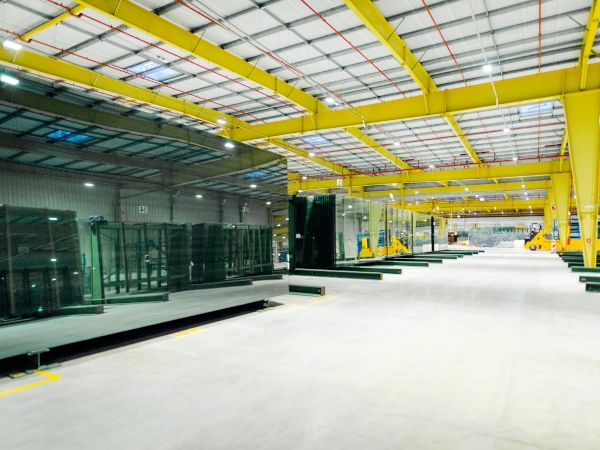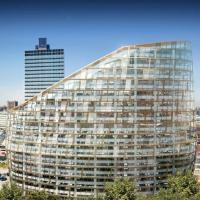
Date: 3 October 2024
One of the new EPDs covers Guardian ExtraClear™ float glass, which is the standard (mid-iron) float glass with the lowest embodied carbon value produced in Europe([1]).
Third-party verified by an independent external verifier (UL), the six EPDs cover the following products:
- Guardian NEXA™ 6 lower carbon glass
- Guardian NEXA™ 9 lower carbon glass
- Guardian UltraClear™ low-iron float glass
- Guardian ExtraClear™ float glass
- Guardian LamiGlass™ and Guardian Bird1st Lami™ laminated glass product ranges
- Coated glass, including (but not limited to) SunGuard™, ClimaGuard™ and Guardian Sun™ products.
The new unprocessed flat glass EPD, which covers Guardian ExtraClear standard float glass produced in Europe, has a cradle-to-gate (A1-A3) embodied carbon value([2]) of 9.64 kg CO2eq/m2 for 4 mm glass. This new value confirms that Guardian ExtraClear is the standard (mid-iron) float glass with the lowest embodied carbon value produced in Europe. A new EPD for Guardian UltraClear™ low-iron float glass produced at the Guardian Glass Bascharage, Luxembourg plant, in Guardian Glass’ most energy efficient furnace, is anticipated to be available in mid 2025.
EPDs are also now available for the new lower carbon glass range of products. Guardian NEXA 6 and Guardian NEXA 9 each have their own EPD, with embodied carbon values for 4 mm glass of 6.38 kg CO2eq/m2 and 8.58 kg CO2eq/m2, respectively. Compared to the average European float glass dataset([3]), this represents a reduction in embodied carbon of more than 40% for Guardian NEXA 6 and 20% for Guardian NEXA 9.
Embodied carbon estimation tool
In parallel with these documents, available for download on the Guardian Glass website, the recently added feature to the Performance Calculator tool (part of Glass Analytics™ software) allows glass processors and specifiers to obtain an estimate of the embodied carbon equivalent for a wide range of glazing combinations. Guardian Glass developed the Performance Calculator tool to help demonstrate the benefits of high-performance glass in building facades. The embodied carbon estimation feature is available for any float glass, coated glass, laminated glass, and coated laminated glass products produced by Guardian Glass in Europe.
Guus Boekhoudt, Executive Vice President, Europe, Africa & Middle East, Asia Pacific and Latin America at Guardian Glass comments: “Our commitment to Stewardship is demonstrated through our sustained efforts to enhance energy efficiency, responsibly manage resources, and reduce air emissions. We are dedicated to continuously seeking innovative solutions that improve our manufacturing processes, exemplified by initiatives such as furnace rebuilds that help increase the energy efficiency of our plants. By investing in advanced furnace technologies and efficiency projects, we have successfully reduced the embodied carbon of our European glass products.”
“By publishing EPDs, we are supporting architects and designers who strive to understand the environmental impacts of the buildings they design through the products they specify. The goal is to provide them with the information they need to calculate their building’s Whole Life Carbon emissions and make informed decisions,” says Jonathan Brunette, ESG & Certification Manager at Guardian Glass. “This transparent, third-party verified data is also helpful for companies working to attain their carbon emissions reduction objectives, whether these targets are voluntary or driven by local regulations such as the Building Whole Life Carbon regulations that are in effect across several countries in Europe including Denmark, Sweden, France and The Netherlands. The data can also help achieve credits in building environmental certification assessment methods such as LEED® or BREEAM®.”
To learn more about our commitment to Stewardship, Guardian NEXA and other new products and digital services from Guardian Glass, meet us at glasstec in Düsseldorf, Germany, 22-25 October 2024 (Hall 10, stand A22).
[1] European comparison based on publicly available EPDs from main float glass manufacturers in Europe as of 19/09/2024.
[2] Global Warming Potential (GWP) of the A1-A3 stages includes the impacts from the raw materials extraction and processing stage, raw materials transportation to the manufacturing site, and the manufacturing of the product. This term is sometimes referred to as the “product carbon footprint” or “embodied carbon”.
[3] When comparing A1-A3 GWP value of NEXA 6 with Sphera Database 2021 Dataset for EU-28 Float flat glass (valid as of June 2024), reduction calculated is -42%. When comparing A1-A3 GWP value of NEXA 9 with Sphera Database 2021 Dataset for EU-28 Float flat glass (valid as of June 2024), reduction calculated is -22%.
 600450
600450




























Add new comment